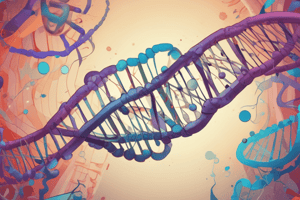Podcast
Questions and Answers
What are the three parts of a nucleotide?
What are the three parts of a nucleotide?
- Phosphate, Ribose Sugar, Nitrogen Base
- Nitrogen Base, Deoxyribose Sugar, Lipid
- Phosphate, Deoxyribose Sugar, Nitrogen Base (correct)
- Phosphate, Deoxyribose Sugar, Glycoprotein
What kind of sugar is found in a nucleotide?
What kind of sugar is found in a nucleotide?
Deoxyribose Sugar
Which nucleotide component contains nitrogen?
Which nucleotide component contains nitrogen?
Base
Name the four nitrogen bases.
Name the four nitrogen bases.
What part(s) of the nucleotides make up the rungs of the 'ladder'?
What part(s) of the nucleotides make up the rungs of the 'ladder'?
What parts of the nucleotides make up the sides (backbone) of the 'ladder'?
What parts of the nucleotides make up the sides (backbone) of the 'ladder'?
Are the rungs parallel or antiparallel?
Are the rungs parallel or antiparallel?
When one nucleotide contains adenine, what type of base is the adenine attached to on the opposite nucleotide strand?
When one nucleotide contains adenine, what type of base is the adenine attached to on the opposite nucleotide strand?
How many hydrogen bonds connect the two bases from Question 4?
How many hydrogen bonds connect the two bases from Question 4?
When one nucleotide contains cytosine, what type of base is the cytosine attached to on the opposite nucleotide strand?
When one nucleotide contains cytosine, what type of base is the cytosine attached to on the opposite nucleotide strand?
How many hydrogen bonds connect the two bases from Question 6?
How many hydrogen bonds connect the two bases from Question 6?
Use a complete sentence to write a rule for how the bases are arranged in the ladder model of DNA.
Use a complete sentence to write a rule for how the bases are arranged in the ladder model of DNA.
Fill in the complementary bases on the strand below according to the base-pair rule.
Fill in the complementary bases on the strand below according to the base-pair rule.
Hydrogen bonds between nucleotides form.
Hydrogen bonds between nucleotides form.
Hydrogen bonds between nucleotides break.
Hydrogen bonds between nucleotides break.
Strands of DNA separate.
Strands of DNA separate.
Free nucleotides are attracted to exposed bases on the loose strands of DNA.
Free nucleotides are attracted to exposed bases on the loose strands of DNA.
What type of biological molecule is DNA helicase?
What type of biological molecule is DNA helicase?
What is the role of DNA helicase in replication of DNA?
What is the role of DNA helicase in replication of DNA?
What rule is used to join the free nucleotides to the exposed bases of DNA?
What rule is used to join the free nucleotides to the exposed bases of DNA?
Explain why DNA replication is called semi-conservative.
Explain why DNA replication is called semi-conservative.
How does semi-conservative replication help prevent mutations during DNA replication?
How does semi-conservative replication help prevent mutations during DNA replication?
What term refers to loose DNA inside of a nucleus?
What term refers to loose DNA inside of a nucleus?
During what part of the cell cycle is the DNA in a cell's nucleus replicated?
During what part of the cell cycle is the DNA in a cell's nucleus replicated?
During what part of the cell cycle is the DNA in a cell condensed into chromosomes?
During what part of the cell cycle is the DNA in a cell condensed into chromosomes?
What structure holds the two sister chromatids together as they prepare for cell division?
What structure holds the two sister chromatids together as they prepare for cell division?
Flashcards are hidden until you start studying
Study Notes
Nucleotides and Their Components
- Three parts of a nucleotide: Phosphate, Deoxyribose Sugar, Nitrogen Base.
- Sugar found in nucleotides is Deoxyribose.
- Nitrogen bases: Adenine, Thymine, Guanine, Cytosine.
Structure of DNA
- Rungs of the DNA "ladder" are formed by Nitrogen Bases.
- Sides (backbone) of the "ladder" are made up of Phosphate groups.
- DNA strands are arranged in an antiparallel configuration.
Base Pairing Rules
- Adenine pairs with Thymine; this forms 2 hydrogen bonds.
- Cytosine pairs with Guanine; this forms 3 hydrogen bonds.
- Specific pairing rules: Guanine pairs with Cytosine, and Thymine pairs with Adenine.
DNA Replication Process
- DNA helicase is an enzyme that breaks DNA strands.
- During replication, free nucleotides match exposed bases according to the complementary base pairing rule.
- DNA replication is described as semi-conservative; each new DNA molecule contains one original and one new strand.
Prevention of Mutations
- Semi-conservative replication maintains original sequence integrity, thus reducing the chance of mutations.
Chromatin and Cell Cycle
- Loose DNA within the nucleus is referred to as Chromatin.
- DNA replication occurs during the Synthesis phase of the cell cycle.
- DNA is condensed into chromosomes during Mitosis.
- Sister chromatids are held together by a structure called the Centromere.
Studying That Suits You
Use AI to generate personalized quizzes and flashcards to suit your learning preferences.




